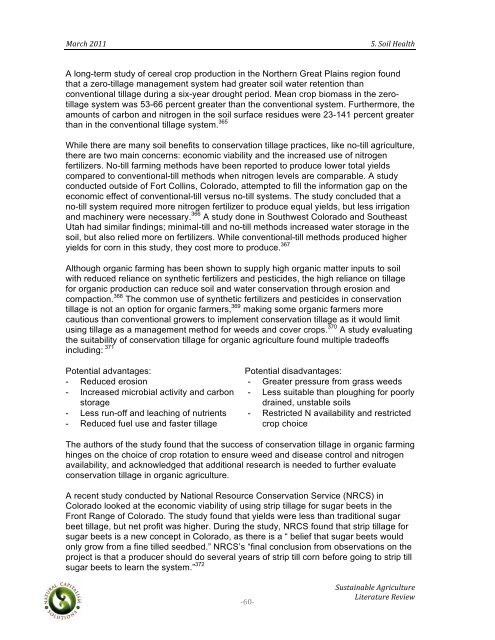Sustainable Agriculture Literature Review - Boulder County
Sustainable Agriculture Literature Review - Boulder County
Sustainable Agriculture Literature Review - Boulder County
You also want an ePaper? Increase the reach of your titles
YUMPU automatically turns print PDFs into web optimized ePapers that Google loves.
! !!<br />
"#$%&!'())!! !!!!!!!!!!!!!!!!!!!!!!!!!!!!!!!!!!!!!!!!!!!!!!!!!!!!!!!!!!!!!!!!!!!!!!!!!*+!,-./!01#/2&!<br />
A long-term study of cereal crop production in the Northern Great Plains region found<br />
that a zero-tillage management system had greater soil water retention than<br />
conventional tillage during a six-year drought period. Mean crop biomass in the zerotillage<br />
system was 53-66 percent greater than the conventional system. Furthermore, the<br />
amounts of carbon and nitrogen in the soil surface residues were 23-141 percent greater<br />
than in the conventional tillage system. 365<br />
While there are many soil benefits to conservation tillage practices, like no-till agriculture,<br />
there are two main concerns: economic viability and the increased use of nitrogen<br />
fertilizers. No-till farming methods have been reported to produce lower total yields<br />
compared to conventional-till methods when nitrogen levels are comparable. A study<br />
conducted outside of Fort Collins, Colorado, attempted to fill the information gap on the<br />
economic effect of conventional-till versus no-till systems. The study concluded that a<br />
no-till system required more nitrogen fertilizer to produce equal yields, but less irrigation<br />
and machinery were necessary. 366 A study done in Southwest Colorado and Southeast<br />
Utah had similar findings; minimal-till and no-till methods increased water storage in the<br />
soil, but also relied more on fertilizers. While conventional-till methods produced higher<br />
yields for corn in this study, they cost more to produce. 367<br />
Although organic farming has been shown to supply high organic matter inputs to soil<br />
with reduced reliance on synthetic fertilizers and pesticides, the high reliance on tillage<br />
for organic production can reduce soil and water conservation through erosion and<br />
compaction. 368 The common use of synthetic fertilizers and pesticides in conservation<br />
tillage is not an option for organic farmers, 369 making some organic farmers more<br />
cautious than conventional growers to implement conservation tillage as it would limit<br />
using tillage as a management method for weeds and cover crops. 370 A study evaluating<br />
the suitability of conservation tillage for organic agriculture found multiple tradeoffs<br />
including: 371<br />
Potential advantages: Potential disadvantages:<br />
- Reduced erosion - Greater pressure from grass weeds<br />
- Increased microbial activity and carbon - Less suitable than ploughing for poorly<br />
storage<br />
drained, unstable soils<br />
- Less run-off and leaching of nutrients - Restricted N availability and restricted<br />
- Reduced fuel use and faster tillage crop choice<br />
The authors of the study found that the success of conservation tillage in organic farming<br />
hinges on the choice of crop rotation to ensure weed and disease control and nitrogen<br />
availability, and acknowledged that additional research is needed to further evaluate<br />
conservation tillage in organic agriculture.<br />
A recent study conducted by National Resource Conservation Service (NRCS) in<br />
Colorado looked at the economic viability of using strip tillage for sugar beets in the<br />
Front Range of Colorado. The study found that yields were less than traditional sugar<br />
beet tillage, but net profit was higher. During the study, NRCS found that strip tillage for<br />
sugar beets is a new concept in Colorado, as there is a “ belief that sugar beets would<br />
only grow from a fine tilled seedbed.” NRCS’s “final conclusion from observations on the<br />
project is that a producer should do several years of strip till corn before going to strip till<br />
sugar beets to learn the system.” 372<br />
!<br />
"%&"<br />
!,342#.5#6/1!78$.%3/23$1!<br />
9.21$#23$1!:1;.1
















